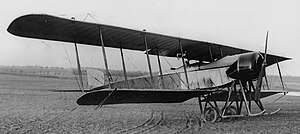|
Paul Schmitt P.S.3
The Paul Schmitt P.S.3 was a French World War I biplane bomber that was built in small numbers but primarily used as a trainer.[1] DevelopmentThe P.S.3 was unusual in that the entire wing cellule was designed to have its angle of incidence adjusted from 0° to 12° while in flight.[2] When set at the maximum, this gave the aircraft a pronounced back-stagger. This was possible because the wing was attached to the fuselage by a single pivot, and controlled by a jackscrew in the cockpit.[2] This allowed for an unusually broad speed range, so that a minimum speed of only 35 km/h (22 mph) was achieved.[2] The fuselage was built up from welded steel tubes, with a square cross section forward tapering to a triangle section aft.[2] One example was built as a floatplane, however unlike most of the landplanes, it was powered by a 150 hp (110 kW) Canton Unné P9 liquid cooled radial in place of the Gnome rotaries normally used. Operational historyAlthough intended as a bomber, it was only ever built in small numbers, and was quickly relegated to use as a trainer, partly because the Aéronautique Militaire had already chosen the Voisin III as their standard bomber. Victorin Garaix set a number of speed and height records while carrying passengers in 1914.[3] The floatplane was exported to a private buyer the US in 1916,[1] only to later be taken on strength by the United States Navy in April 1917 with the serial A-52, however it was used primarily as an instructional airframe at Pensacola for training groundcrew.[4] OperatorsSpecifications (Paul Schmitt P.S.3) Data from Davilla, 1997, p.451 General characteristics
Performance
ReferencesWikimedia Commons has media related to Paul Schmitt P.S.3. CitationsBibliography
|
||||||||||||||||||||
